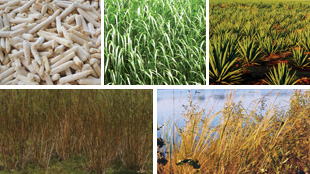GREEN biofuel, not from food crops

Sources of cellulosic biofuels
Ethanol is traditionally made from food crops like corn, wheat, soybean, and sugarcane. However, biofuels can also be made from cellulosic feedstocks such as energy (non-food) crops. Cellulosic biofuel feedstocks also include various sources of waste from forestry, agriculture waste and other farm and municipal waste, used paper products, algae, and other biodegradable organic matter.
Sources of cellulosic biofuel production are abundant, energy dense, and don't draw from food sources essential to address dietary needs worldwide.
Examples of feedstocks for cellulosic biofuel are - switchgrass, poplar, Miscanthus grass, other lingocellulsic energy crops grown specifically for biofuel production, corn stover, rice hulls, crop residues, straw, paper pulp, wood residues, sawdust, wood chips, other forestry and agricultural waste, the byproducts of lawn and tree maintenance; as well as the most promising 3rd generation biofuel source currently being researched, developed, and implemented in commercial applications - algae. Algae, and the non-food energy crops listed above, help resolve the conflict that arises from using 1st generation agricultural crops as sources for biofuel.
Once the organic biodegradable, organic matter to make the cellulosic biofuel (from the feedstocks listed above) is broken down with enzymes - it can be fermented to make ethanol or biodiesel. Cellulosic biofuel, and other alternative sources of biofuels, can be used to reduce greenhouse gasses (compared to using conventional fossil fuels). Cellulosic sources of biofuel don't draw from vital agricultural crop sources needed as food supplies. Cellulosic sources of biofuel include 2nd and 3rd generation sources of biofuel production, but not 1st gen agricultural sources; thus avoiding use of vital agricultural crops needed as food throughout the world.
Waste as a source of cellulosic biofuel
There are tons of cellulose-containing raw materials that could be used to produce biofuels that are simply thrown away each year in the U.S. alone. Examples of this waste that is tossed into landfills instead of generating renewable energy are: over 100 million dry tons/ year of urban wood wastes and forest residues, and over 150 million dry tons/ year of corn stover and wheat straw. That material plus a viable chunk of the other paper, wood, and plant products currently treated as waste and simply disposed of, could instead be used to produce biofuel.
Creating energy from waste, instead of waste just ending up in landfills, would effectively reduce GHGs, in addition to other pollutants, help the environment, and help the economy. This theme is true in many countries throughout the world. It's especially true that there are increased environmental benefits, more GHGs are sequestered in the biofuel production process, and waste is reduced, when the cellulosic fuel source is regenerated - so as to maximize the sustainability of cellulosic biofuel production.
Creating biofuels with cellolosic sources
It is necessary to first covert any cellulosic fuel source into a usable form for energy production - glucose; because the original form of cellulosic organic matter is not able to be processed into biofuels directly. Biofuel production from cellulosic sources involves this additional step, the breakdown of the raw material into glucose with enzymes. Glucose is then fermented to make biofuels; as the final step in the process of converting cellulosic biomass materials into biofuel. Financial concerns stemming from the cost of processing biofuel from cellulosic organic matter have stopped cellulosic biofuel from really taking off; and providing a consistent source of renewable energy, in some markets.
All biofuels represent a significant GHG emissions reduction compared to fossil fuels; however cellulosic raw material is abundant, and potential GHG emissions reductions from use of cellulosic biofuels may be greater than those from traditional 1st generation biofuels. Importantly, cellulosic biofuel sources are not vital agricultural crops, as are first generation biofuel sources.
Non-food and non-waste/ agricultural by-product cellulosic raw material, such as energy crops, can be easily grown in land that is determined as marginal for actual agricultural land for food crops. Other cellulosic material; such as farm, agricultural, industrial, and municipal waste and other organic biodegradable material, may simply be diverted from landfills to be used in biofuel production, reducing the costs associated with landfills. Cost-effective processes, such as using inexpensive enzymes to break down the cellulose in the advanced cellulosic biofuel production process, are being researched and developed as well.
Please see: Algae - the future of biofuel
Please also see: renewable energy: biomass and biofuel